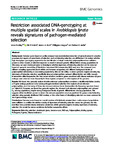Restriction associated DNA-genotyping at multiple spatial scales in Arabidopsis lyrata reveals signatures of pathogen-mediated selection
| dc.contributor.author | Buckley, James | |
| dc.contributor.author | Holub, EB | |
| dc.contributor.author | Koch, MA | |
| dc.contributor.author | Vergeer, P | |
| dc.contributor.author | Mable, BK | |
| dc.date.accessioned | 2020-09-15T08:11:58Z | |
| dc.date.issued | 2018-06-27 | |
| dc.identifier.issn | 1471-2164 | |
| dc.identifier.issn | 1471-2164 | |
| dc.identifier.other | 496 | |
| dc.identifier.uri | http://hdl.handle.net/10026.1/16273 | |
| dc.description.abstract |
BACKGROUND: Genome scans based on outlier analyses have revolutionized detection of genes involved in adaptive processes, but reports of some forms of selection, such as balancing selection, are still limited. It is unclear whether high throughput genotyping approaches for identification of single nucleotide polymorphisms have sufficient power to detect modes of selection expected to result in reduced genetic differentiation among populations. In this study, we used Arabidopsis lyrata to investigate whether signatures of balancing selection can be detected based on genomic smoothing of Restriction Associated DNA sequencing (RAD-seq) data. We compared how different sampling approaches (both within and between subspecies) and different background levels of polymorphism (inbreeding or outcrossing populations) affected the ability to detect genomic regions showing key signatures of balancing selection, specifically elevated polymorphism, reduced differentiation and shifts towards intermediate allele frequencies. We then tested whether candidate genes associated with disease resistance (R-gene analogs) were detected more frequently in these regions compared to other regions of the genome. RESULTS: We found that genomic regions showing elevated polymorphism contained a significantly higher density of R-gene analogs predicted to be under pathogen-mediated selection than regions of non-elevated polymorphism, and that many of these also showed evidence for an intermediate site-frequency spectrum based on Tajima's D. However, we found few genomic regions that showed both elevated polymorphism and reduced FST among populations, despite strong background levels of genetic differentiation among populations. This suggests either insufficient power to detect the reduced population structure predicted for genes under balancing selection using sparsely distributed RAD markers, or that other forms of diversifying selection are more common for the R-gene analogs tested. CONCLUSIONS: Genome scans based on a small number of individuals sampled from a wide range of populations were sufficient to confirm the relative scarcity of signatures of balancing selection across the genome, but also identified new potential disease resistance candidates within genomic regions showing signatures of balancing selection that would be strong candidates for further sequencing efforts. | |
| dc.format.extent | 496- | |
| dc.format.medium | Electronic | |
| dc.language | en | |
| dc.language.iso | en | |
| dc.publisher | Springer Science and Business Media LLC | |
| dc.subject | Balancing selection | |
| dc.subject | Arabidopsis lyrata | |
| dc.subject | Genome scan | |
| dc.subject | RAD-seq | |
| dc.subject | Polymorphism | |
| dc.subject | Mating system | |
| dc.subject | Pathogens | |
| dc.subject | R-genes | |
| dc.subject | Disease resistance | |
| dc.title | Restriction associated DNA-genotyping at multiple spatial scales in Arabidopsis lyrata reveals signatures of pathogen-mediated selection | |
| dc.type | journal-article | |
| dc.type | Journal Article | |
| plymouth.author-url | https://www.webofscience.com/api/gateway?GWVersion=2&SrcApp=PARTNER_APP&SrcAuth=LinksAMR&KeyUT=WOS:000436610200001&DestLinkType=FullRecord&DestApp=ALL_WOS&UsrCustomerID=11bb513d99f797142bcfeffcc58ea008 | |
| plymouth.issue | 1 | |
| plymouth.volume | 19 | |
| plymouth.publication-status | Published | |
| plymouth.journal | BMC Genomics | |
| dc.identifier.doi | 10.1186/s12864-018-4806-7 | |
| plymouth.organisational-group | /Plymouth | |
| plymouth.organisational-group | /Plymouth/Faculty of Science and Engineering | |
| plymouth.organisational-group | /Plymouth/Faculty of Science and Engineering/School of Biological and Marine Sciences | |
| plymouth.organisational-group | /Plymouth/REF 2021 Researchers by UoA | |
| plymouth.organisational-group | /Plymouth/REF 2021 Researchers by UoA/UoA06 Agriculture, Veterinary and Food Science | |
| plymouth.organisational-group | /Plymouth/REF 2021 Researchers by UoA/UoA06 Agriculture, Veterinary and Food Science/UoA06 Agriculture, Veterinary and Food Science MANUAL | |
| plymouth.organisational-group | /Plymouth/Users by role | |
| plymouth.organisational-group | /Plymouth/Users by role/Academics | |
| dc.publisher.place | England | |
| dcterms.dateAccepted | 2018-05-18 | |
| dc.rights.embargodate | 2020-9-19 | |
| dc.identifier.eissn | 1471-2164 | |
| dc.rights.embargoperiod | Not known | |
| rioxxterms.versionofrecord | 10.1186/s12864-018-4806-7 | |
| rioxxterms.licenseref.uri | http://www.rioxx.net/licenses/all-rights-reserved | |
| rioxxterms.licenseref.startdate | 2018-06-27 | |
| rioxxterms.type | Journal Article/Review |


